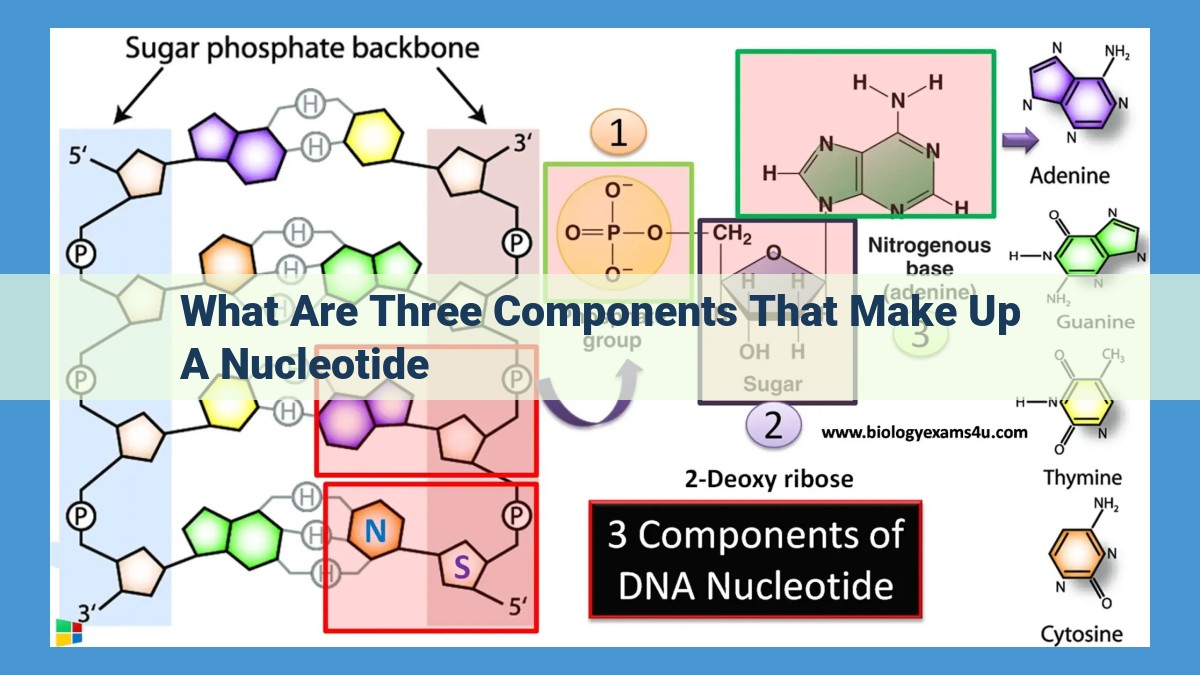Nucleotide components:
- Phosphate group: Provides backbone and stabilization.
- Sugar (ribose or deoxyribose): Forms structural framework and stabilizes base pairing.
- Nitrogenous base (A, C, G, T in DNA; U in RNA): Encodes genetic information through specific base pairing.
Nucleotides: The Building Blocks of Life
In the tapestry of life, there exists an intricate world beyond our visible reality – the microscopic realm of molecules. Among these molecules, nucleotides stand out as the fundamental units that carry the blueprints of our genetic heritage and the instructions for all life processes.
Picture nucleotides as the tiny building blocks that form the very fabric of our genes, the DNA and RNA that reside within every cell. These molecules, similar to Lego bricks, assemble in specific sequences to encode the genetic information that governs our traits, from eye color to predisposition to diseases. Without nucleotides, there would be no life as we know it. They are the keepers of our genetic legacy, ensuring the continuity of life across generations.
Meet the Phosphate Group: Backbone and Stabilizer
In the realm of life’s intricate machinery, nucleotides reign supreme as the fundamental building blocks responsible for storing and transmitting genetic information. Within these tiny molecules lies a vital component – the phosphate group.
Structure and Polarity:
The phosphate group is a negatively charged inorganic ion consisting of three oxygen atoms bonded to a phosphorus atom. Its structure resembles a pyramid, with the phosphorus atom at its apex and the oxygen atoms arranged around its base. This unique arrangement creates a polarity within the phosphate group, with a partial negative charge on the oxygen atoms and a partial positive charge on the phosphorus atom.
Backbone of Nucleotide Chains:
Within nucleotides, phosphate groups play a pivotal role in forming a chain-like backbone. They link together the deoxyribose or ribose sugar molecules, creating the backbone of DNA and RNA molecules, respectively. This backbone provides stability and structural support to the nucleotide chains.
Significance in Interactions:
The phosphate group’s polarity contributes significantly to the interactions within DNA and RNA molecules. The negative charge of the phosphate groups electrostatically repels neighboring negative charges, maintaining the structural integrity of the nucleic acid molecules. This charge repulsion also facilitates the unwinding and rewinding of DNA during genetic processes such as replication, transcription, and translation.
Interactions within DNA:
In the double helix structure of DNA, base pairing between nitrogenous bases (adenine-thymine and cytosine-guanine) establishes the hydrogen bond network that holds the two strands together. The phosphate groups, located on the exterior of the double helix, stabilize these interactions by neutralizing the positive charges of the hydrogen bonds.
Interactions within RNA:
RNA molecules exhibit a diverse range of structures, including complex three-dimensional shapes. The phosphate groups play a crucial role in stabilizing these structures by forming hydrogen bonds with the hydroxyl groups of the ribose sugar molecules. These interactions contribute to the formation of loops, bulges, and other intricate structures essential for RNA’s functionality.
Ribose and Deoxyribose: The Structural Skeletons of Nucleic Acids
In the realm of life’s blueprints, nucleotides reign supreme as the building blocks of genetic information. These remarkable molecules carry the secrets of our inheritance, orchestrating the symphony of life from one generation to the next.
Among the essential components of nucleotides are sugars – the structural frameworks that provide stability and shape to the genetic code. Two sugar siblings share this crucial role: ribose and deoxyribose.
Ribose graces the nucleotides of RNA (ribonucleic acid), while deoxyribose resides in the nucleotides of DNA (deoxyribonucleic acid). Structurally, they differ by a single oxygen atom. Ribose sports an OH group at its 2′ carbon atom, while deoxyribose lacks this oxygenic adornment.
Their presence in RNA and DNA is not a coincidence. Ribose’s 2′ _OH group stabilizes crucial hydrogen bonds between nitrogenous bases. This interaction enables RNA molecules to adopt a diverse array of intricate structures, essential for their regulatory roles in gene expression. In contrast, the lack of the 2′ _OH group in deoxyribose contributes to the double helix structure of DNA. This iconic spiral staircase safeguards the genetic information from environmental hazards and facilitates its precise replication.
Thus, ribose and deoxyribose, though similar in their sugar nature, play distinct roles in the structure and function of RNA and DNA. As the backbone of genetic information, they silently toil, providing the structural support that allows life’s blueprint to endure, evolve, and unravel the tapestry of biological wonders.
Nitrogenous Bases: The Code of Life
Within the intricate tapestry of nucleotides, the nitrogenous bases emerge as the true architects of genetic information. These heterocyclic aromatic compounds possess a captivating molecular dance that orchestrates the awe-inspiring symphony of life.
In the realm of DNA, the four noble bases – Adenine (A), Cytosine (C), Guanine (G), and Thymine (T) – take center stage. They gracefully pair with each other, forming the iconic base pairing principles of A-T and C-G. These interactions are the very foundation upon which DNA’s double helix is constructed, a masterpiece of genetic storage.
Venture into the realm of RNA, and a slight switch occurs. Uracil (U) replaces Thymine, adding a captivating twist to the genetic code. Together, these bases orchestrate the formation of diverse RNA structures, ranging from the messenger RNA that carries genetic instructions to the ribosomal RNA that facilitates protein synthesis.
The nitrogenous bases are not mere passive bystanders in the genetic realm. Their interactions and variations spawn the immense diversity of life forms that grace our planet. From humans to microscopic creatures, the code they carry dictates the blueprint of life, guiding the development of traits, shaping our identities, and ultimately composing the very essence of our existence.
Understand the intricate world of nucleotides, and you unlock the secrets to unraveling the mysteries of life. The nitrogenous bases stand as the captivating storytellers of our genetic inheritance, weaving a narrative that spans the boundaries of time and connects all living beings.
